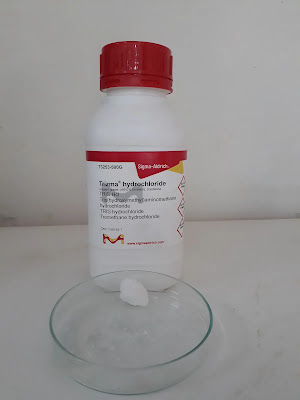Contents
hide
CHEMICAL PRODUCT IDENTIFICATION
- Product Name: Tris(hydroxymethyl)aminomethane hydrochloride
- CAS Number: 1185-53-1.
- Signal Word: Warning!
- Read – TRIS HCl SDS!
HAZARDS IDENTIFICATION
- The 2012 OSHA Hazard Communication Standard does not classify this substance as dangerous (29 CFR 1910.1200).
COMPOSITION, INFORMATION ON INGREDIENTS
- Component Name: 1,3-Propanediol, 2-amino-2-(hydroxymethyl)-, hydrochloride.
- Molar Mass/Formula Wt.: 157.60 g/mol
- Synonyms: Tromethane; 2-Amino-2-(hydroxymethyl)-1,3-propanediol, hydrochloride; TRIS;Tromethamine.
FIRST-AID MEASURES
- If you feel unwell, contact a doctor.
- If inhaled: Remove the victim to fresh air & keep them at rest in a breathing-friendly position.
- If in the eyes: Carefully rinse for a few minutes with water. If contact lenses are present & simply possible to remove, do so. Rinsing continues.
- If on the skin: Thoroughly rinse with water.
- If skin irritation happens: consult the doctor or take medical advice.
- If Swallowed: Rinse mouth if swallowed. If you feel unwell, contact a doctor.
FIRE-FIGHTING MEASURES
- Toxic gases could be released during decomposition when heated.
- Use a tri-class dry chemical fire extinguisher in the event of a fire.
- Dangerous Decomposition Products: Nitrogen Oxides (NOx). Carbon monoxide (CO). Carbon dioxide (CO2). Hydrogen chloride gas.
- Keep away from heat & ignition sources.
ACCIDENTAL RELEASE MEASURES
- Keep solid away from going airborne.
- Ventilate the area.
- Clean up the spill, put it in a container or bag, & then throw it away.
- After substance pickup is complete, clean the spill scene.
- Detach all sources of ignition.
HANDLING & STORAGE
- Avoid creating dust. Avoid contacting your skin, clothing, or eyes.
- Store in a cool, dry, well-ventilated area.
- Keep the container firmly shut.
- Avoid ingesting & breathing.
- Keep moisture out.
EXPOSURE CONTROLS, PERSONAL PROTECTION
- Wear appropriate eye protection, gloves, & clothes.
- After handling, carefully wash your hands.
- Use only in a well-ventilated room or under a hood.
PHYSICAL & CHEMICAL PROPERTIES
- Appearance: White (Solid).
- Molecular Formula: C4 H11 N O3 . H Cl
- Molecular Weight: 157.6
- Odor: It is slightly characteristic.
- pH: 3.5-5.0 @ 25°C 1-% aq.sol. (25°C).
- Boiling point: 225 °C (437 °F)
- Melting point: 150°C – 151 °C (302°F – 303.8 °F).
- Density: 1.28 g/cm3.
- Solubility: Water (Soluble).
STABILITY & REACTIVITY
- Prevent all contact with strong oxidizers & bases.
- It has a limited & hygroscopic shelf life.
- Decomposition of hazardous products: Carbon monoxide (CO), carbon dioxide (CO2), nitrogen oxides (NOx), & hydrogen chloride gas.
TOXICOLOGICAL INFORMATION
- Acute Effect: N/A.
- Chronic effect: N.A
- Targeted Organ: Skin, respiratory system, & eye irritation
- ORL-RAT LD50(OECD 425): 5000 mg/kg bw.
- IHL- LC50: Not Listed.
- SKN-RAT LD50(OECD 402):5000 mg/kg bw.
ECOLOGICAL INFORMATION
- Ecotoxicity: Avoid emptying into drains.
- Degradability & Durability: soluble in H2O Based on the evidence supplied, persistence is doubtful.
- Mobility: Due to its water solubility, it will probably be mobile in the environment.
DISPOSAL CONSIDERATIONS
- Dispose of in accordance with local, state, & federal rules or laws.
TRANSPORT INFORMATION
- Not Regulated.
REGULATORY INFORMATION
- US EPA (TSCA) – Toxic Substances Control Act, X- Listed.
- TSCA 12(b) – Export Notices:- Not Applicable.
OTHER INFORMATION
This TRIS HCl SDS is intended as a piece of advice & is based on data & tests that are likely to be reliable. I don’t guarantee the data’s correctness or completeness & I’m not responsible for any resulting losses. The information is only being provided for your review, research, & verification. I DO NOT ASSUME RESPONSIBILITY AND EXPRESSLY DISCLAIM LIABILITY FOR LOSS, DAMAGE, OR EXPENSE RESULTING FROM OR IN ANY WAY CONNECTED WITH THE HANDLING, STORAGE, USE, OR DISPOSAL OF THIS PRODUCT FOR THE FOREGOING AND OTHER REASONS.

CONCLUSION
A buffer frequently used in biochemistry & molecular biology research is called Trizma Hydrochloride (TRIS-HCl). Even though it is thought to be a chemical of low toxicity, if handled incorrectly, it can nevertheless irritate the skin, eyes, & respiratory system. When handling or working with TRIS-HCl, it’s critical to use the proper personal protection equipment, including goggles, gloves, & a face mask, & to adhere to all safety precautions. Remember that breathing in dust can cause respiratory irritation, so it’s crucial to have enough ventilation & refrain from doing so. One must follow TRIS HCl SDS while handling this product.
